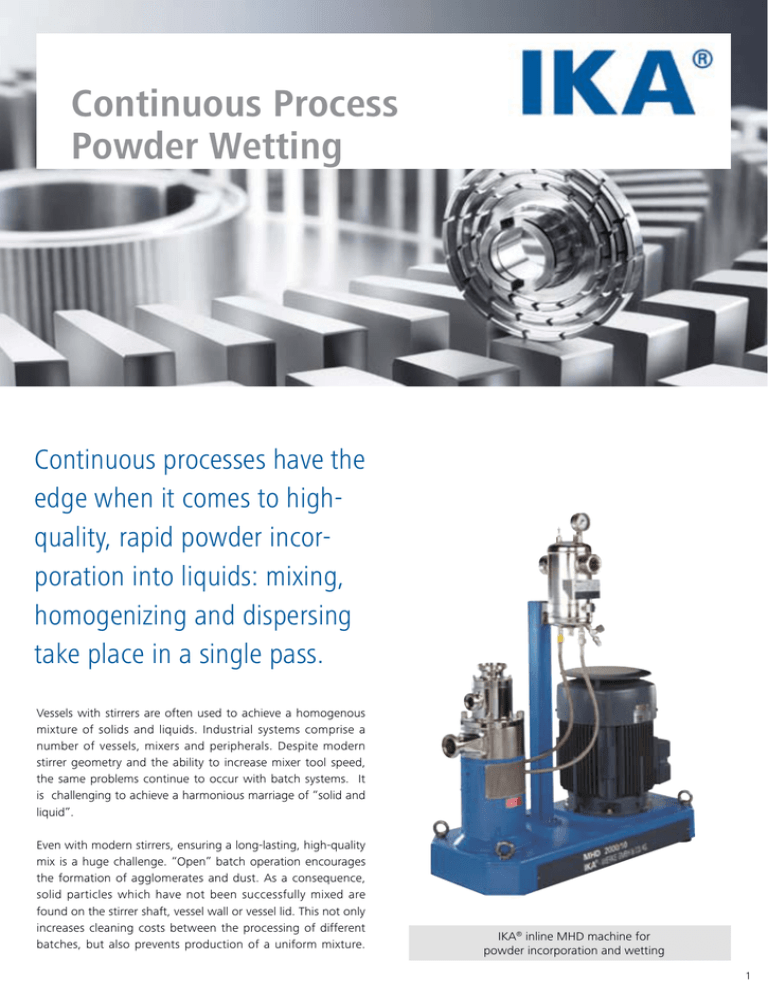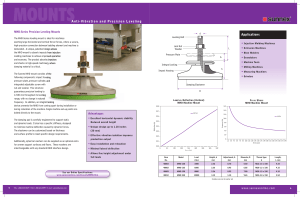Continuous Process Powder Wetting
advertisement

Continuous Process Powder Wetting Continuous processes have the edge when it comes to highquality, rapid powder incorporation into liquids: mixing, homogenizing and dispersing take place in a single pass. Vessels with stirrers are often used to achieve a homogenous mixture of solids and liquids. Industrial systems comprise a number of vessels, mixers and peripherals. Despite modern stirrer geometry and the ability to increase mixer tool speed, the same problems continue to occur with batch systems. It is challenging to achieve a harmonious marriage of “solid and liquid”. Even with modern stirrers, ensuring a long-lasting, high-quality mix is a huge challenge. “Open” batch operation encourages the formation of agglomerates and dust. As a consequence, solid particles which have not been successfully mixed are found on the stirrer shaft, vessel wall or vessel lid. This not only increases cleaning costs between the processing of different batches, but also prevents production of a uniform mixture. IKA® inline MHD machine for powder incorporation and wetting 1 If air is used as a delivery medium for the solid, there is a possibility of unwanted air being entrained into the mix. Dust and solvent emissions are also a problem from the point of view of workplace safety, as they present a potential health risk to employees. It can be financially attractive to look for alternatives to conventional batch process. Depending on the type of operation, some product components may be “treated” more than actually necessary in a batch process, others less. In order to obtain satisfactory product quality over the batch as a whole, lengthy mixing and/or dispersion is required. This process increases energy consumption, which produces significant heat in the products. For all these reasons, modern continuous powder wetting systems are seen as increasingly attractive options, even for relatively small quantities. Solid and liquid become one. MHD plants for mixing, homogenization and dispersing Modern inline systems overcome the disadvantages of conventional batch processes. IKA® MHD plant, for example, operates as a continuous process. Its name comes from the functions it performs: Mixing, Homogenizing and Dispersing of solid and liquid phases in a single pass. In an MHD mixing and dispersing machine, the product components are dosed in the correct proportions, then mixed, dispersed and discharged. Dosage of the solid in simple cases is via a volumetric dosage device. The dosage is dependent on the volume introduced per unit of time and remains constant for the same bulk density and uniform filling of the dosage hopper. Section view of the IKA MHD module If greater accuracy is required or complex substances are to be input, gravimetric dosage is used. The various solids and dosage quantities are weighed on scales and compared with the pre-determined requisite amounts. Any discrepancies are automatically adjusted via a controlled drive. Changes in the bulk weight or material properties do not affect the dosage result. Concentration accuracies to within 0.5 percent by mass or better can be achieved. The slightly higher dosage cost is offset several times over. Other advantages include: small reservoir capacity requirements and no additional mixing machines are required. Delivery, dosage, mixing While the solid is fed into the MHD from above, the liquid component of the mixture is introduced into the processing chamber at the side. The liquid is separated into a large number of individual streams in a special drum by means of a perforated nozzle and injected into a pre-mixing chamber. Gravity transports the solid onto the spiral blades of a conveyor screw which functions as a “sluice gate” The solid is fed downwards into the mixing chamber. solids inlet liquids inlet outlet The patented design of the MHD module prevents splashes of liquid from reaching the solid inlet area, thus reliably preventing lumps from forming and ensuring that no problems occur with feeding the solid into the machine. MHD plant flow diagram 2 The phases come together in the pre-mixing chamber and are mixed efficiently with a special tool. The multi-part, highspeed mixing tool creates a highly turbulent flow in the mixing chamber resulting in optimum wetting and mixing of the solid particles. clean components have earned a 3A certification. On request, the MHD system can be supplied with silo, big-bag or sack emptying units. The MHD system can also be configured as a complete production line with all associated powder or storage containers, pipework, heating/cooling equipment or a full measurement and control system for automatic operation. The level of automation can be adapted to suit all requirements, from simple manual operation to a fully automated system. Broad range of applications MHD systems cover a broad range of applications. Business sector use includes: chemical, cosmetic and food industries. Continuous proportional quantity mixing is suitable for a great many initial products. Section view of the IKA inline MHD machine Up to three rotor-stator tool systems can be used in the bottom section of the mixing chamber to disperse the pre-wetted mixture finely or to break it down wet. Depending on the initial materials, very fine suspensions can be produced continuously in a single pass. The product leaves the processing chamber through the discharge outlet, where a delivery pressure of up to 2 bars can be created. The following products are suitable for the liquid phase: water, oils, resins, kerosene, alcohols, liquid polymers, low to high viscosity dispersions, molten urea, syrup or solvents. The following solids can be mixed with the fluid in each case: starch products, Carbopol®, Aerosil®, nuts, ammonium sulfate, aluminum oxide, spice powder, talcum, mineral pigments, coating products, reactive powder, polyamide fibers, thickeners, cellulose, fuller’s earth, carbon black, pectin, pellets, etc. Suspensions with concentrations of 50% aluminum silicate, for example, can be produced in a continuous process. For the bleaching process, used in the preparation of vegetable oils, the IKA® MHD 2000 machine is capable of combining the oil and fuller’s earth in a single pass. Higher solid input Depending on the product, up to 80% solid content can be input in a single pass. The MHD can produce anything from high viscosity products to pastes in the 50,000 mPas range. Because the product only passes through the machine once, only a small amount of heat is generated and the product spends a short time in the machine. This is particularly important in the case of reactive processes and rapid increases in viscosity. The particle sizes in the suspensions produced by the MHD 2000 depend on the initial materials. Most frequently, resulting particle sizes are in the range approx. 10 to100 µm. Versatile MHD machines suitable for sterile conditions are available for use in the food industry. The high-quality design and easy to IKA® MHD 2000/30 machine 3 A modified version of the MHD plant is used successfully for the production of polymer-modified bitumen. Here, a polymer (generally styrene-butadiene-styrene) is added to the liquid bitumen which has been heated to approx. 180 °C. The end product is used in the construction of roads and airport runways, and is also in demand for high-quality roofing and waterproofing membranes. Industry: Petrochemicals / Road building Liquid Bitumen Solid Polymer (SBS) End product Polymer-modified bitumen for road building Supplied as Complete plant for the continuous production of 35,000 kg/h of polymer-modified bitumen Continuous process IKA® MHD system with solid and liquid dosage units Advantages of the continuous process over batch processes: • Efficient energy input • Machine-guided product flow • Variable, multi-stage rotor / stator systems • Narrow particle size distribution and good reproducibility • Compact • Flexible production quantities • No dust and solvent emissions • Easy cleaning • Reliable scale-up • Ideal for relatively large production volumes IKA® plant for the production of polymer-modified bitumen (PmB) 4 level, IKA® pilot plants give a realistic idea of the manufacturing plant requirements. The design is the same as that of subsequent production-scale machinery and plant. IKA® magic LAB® inline laboaratory machine with powder input module Scale-up In times of increasingly short product cycles, efficient scaleup is ever more important. Scaling up new processes to the required manufacturing level has, therefore, now become one of the key disciplines in process engineering. At the laboratory IKA® magic LAB®, LABOR-PILOT and PROCESS-PILOT help with selection of the process technology to be used in each case. Interchangeable modules enable a wide range of process techniques to be used in response to actual requirements and formulations. The IKA® pilots are used to determine: machine and plant sizes, and the associated energy requirements. The required raw material quality and quantity can also be determined precisely at the laboratory level. The most important question of all can be answered before scaling up. What quality characteristics must the end product possess? From the beginning, IKA® pilots give project planners maximum certainty for planning and achieving a fully professional mix quality. IKA® MHD pilot plant for the continuous mixing of solids and liquids IKA® - Works, Inc. 2635 Northchase Pkwy SE, Wilmington, NC · USA Tel: +1 910 452-7059 · Fax: +1 910 452-7693 process@ikausa.com · www.ikausa.com 5


